ACTION ON AIDS
|
THE GLOBAL RESPONSE
"[T]o uproot the epidemic it will be necessary to deal with its root societal causes—namely a lack of respect for human rights."
—Jonathan Mann, 1996
In 1986, the World Health Organization (WHO) launched a program to evaluate the scope of the global AIDS pandemic and to plan an international,
integrated response. Jonathan Mann, a physician and human rights advocate, led the Global Programme on AIDS (GPA), advising governments and advocacy
organizations on ways to prevent the spread of the disease. By 1989, the GPA was working with groups in more than 160 countries around the world.
The United Nations now leads ten organizations, including the WHO, to coordinate global AIDS efforts (UNAIDS). As the crisis continues, a new generation
will be called upon to join in this work.
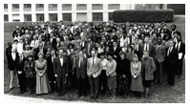 Jonathan Mann and the Global Programme on AIDS, 1987
Jonathan Mann and the Global Programme on AIDS, 1987Courtesy WHO
In 1987, AIDS became the first disease ever debated at the United Nations General Assembly, when Jonathan Mann delivered a special briefing on the pandemic. As part of the
Universal Declaration of Human Rights in 1948, the organization acknowledged that everyone has a right to housing, food, medical care, and services needed for health and well-being.
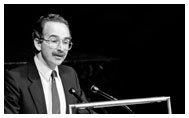 Jonathan Mann, United Nations General Assembly, 1987
Jonathan Mann, United Nations General Assembly, 1987Courtesy UN/DPI Photo by Saw Lwin
Mann believed that protecting the rights of people with HIV was essential and argued that measures such as quarantine or mandatory testing would drive infected people into
hiding. He also understood that infringements of rights caused by poverty and exclusion made people more vulnerable to the disease. Mann's focus on human rights helped set the tone for world efforts
and, in 1999, the United Nations adopted a resolution against discrimination in health in response to the lessons of AIDS.
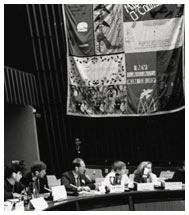 World AIDS Day Youth Forum, World Health Organization, 1988
World AIDS Day Youth Forum, World Health Organization, 1988Courtesy WHO/T. Farkas
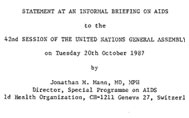 Jonathan Mann's speech to the United Nations General Assembly, 1987
Jonathan Mann's speech to the United Nations General Assembly, 1987Courtesy United Nations Photo Library
This content requires javascript and Adobe Flash Player 8 or higher.
Please ensure that javascript is enabled and download the latest Flash Player.
MAKING A DIFFERENCE:
Dr. Victoria Cargill invites others to get involved in HIV/AIDS issues.
Transcript
This content requires javascript and Adobe Flash Player 8 or higher.
Please ensure that javascript is enabled and download the latest Flash Player.
FIGHTING HIV/AIDS:
Student activist Gyawu Mahama describes the reason he joined the global response.
Transcript
This content requires javascript and Adobe Flash Player 8 or higher.
Please ensure that javascript is enabled and download the latest Flash Player.
GETTING INVOLVED:
Medical student Hanni Stoklosa talks about her contribution.
Transcript
"What I did was not controversial; it was necessary..." —Mechai Viravaidya, 2007
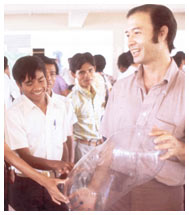 "The Condom King," Mechai Viravaidya, promoting condom use, 1970s
"The Condom King," Mechai Viravaidya, promoting condom use, 1970sCourtesy Population and Community Development Association
The first case of AIDS was reported in Thailand in 1984. Mechai Viravaidya, who had been distributing condoms since the 1970s to promote family planning, highlighted the risks of an epidemic.
He was not supported by the Thai government, however, which saw the disease primarily as a problem for foreigners who might spread the disease to small high-risk groups, but not the wider population.
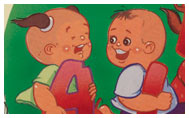 Learn English and Be Smart About AIDS, ca. 2000
Learn English and Be Smart About AIDS, ca. 2000Courtesy Population and Community Development Association
 AIDS education, Bangkok, Thailand, 2004
AIDS education, Bangkok, Thailand, 2004Courtesy Population and Community Development Association
Thailand is considered one of the biggest success stories in the fight against AIDS because of the great strides made in the 1990s. However, in recent years funding for HIV prevention efforts
has declined. As in all countries, without ongoing efforts to educate people on the ways to protect themselves from infection, the disease will continue to spread.
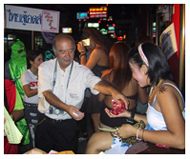 Mechai Viravaidya, distributing condoms to sex workers, Pattaya, Thailand, ca. 2000
Mechai Viravaidya, distributing condoms to sex workers, Pattaya, Thailand, ca. 2000Courtesy Population and Community Development Association
In 1991, Thailand's new Prime Minister Anand Panyarachun made AIDS prevention and control a priority. He appointed Viravaidya to the government, to launch AIDS education in all schools, and to
broadcast information every hour on state-owned radio and television. The "100 percent condom program" was developed to distribute free condoms in restaurants, taxis, shops, and brothels.
 Making a "chain of life" out of condoms with Miss Thailand, World AIDS Day, 2006
Making a "chain of life" out of condoms with Miss Thailand, World AIDS Day, 2006Courtesy Population and Community Development Association
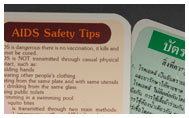 AIDS information cards, ca. 2000
AIDS information cards, ca. 2000Courtesy Population and Community Development Association
Next
 "The Condom King," Mechai Viravaidya, promoting condom use, 1970s
"The Condom King," Mechai Viravaidya, promoting condom use, 1970s Mechai Viravaidya, distributing condoms to sex workers, Pattaya, Thailand, ca. 2000
Mechai Viravaidya, distributing condoms to sex workers, Pattaya, Thailand, ca. 2000






